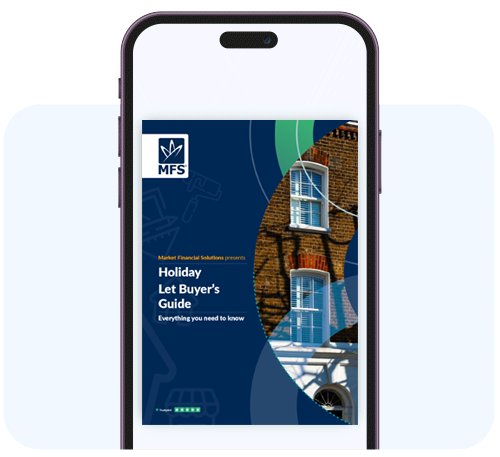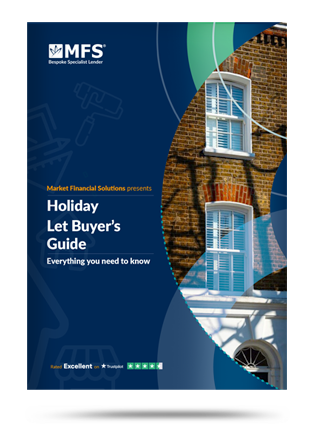A complete guide
- What to consider when buying a holiday let
- Costs, pricing strategies, income & yields
- Rules & regulations
- Finance options & calculator and more
Get your free Holiday Let Buyer’s Guide below.

Holiday Let Buyer’s Guide
A complete guide to buying a holiday let
Holiday lets have come to the forefront in recent years, given the impact of the pandemic and the emergence of “staycations”. Regardless of whether property investors have already included holiday lets in their portfolio or not, they’re likely to be on many people’s radars.
This side of the market can be tricky to navigate, however. Increased competition, local pushback, and other issues may potentially make it harder for investors to progress.
As such, this holiday let buyer’s guide will break down everything property investors need to know about the holiday let market, while providing them with clarity on what their next steps could be to buy a holiday let.

What is a holiday let?
Holiday lets, sometimes known as short term lets or seasonal lets, are properties rented out primarily by tourists. They’re often found in locations that are desirable for holiday makers, such as near a beach or a city centre.
They are typically utilised on a short term basis, depending on the renter’s plans. A tenant may want to get away to a seaside town for just a weekend. Whereas others may need a place to stay for several weeks.
Holiday lets can come in many shapes and sizes. There are typical examples such as standalone houses, cottages, cabins, or apartments. Then there are more luxurious or niche options, which can include villas, beach houses, or even chalets.

Are holiday lets a good investment?
The success of any investment will be dependent on an investor’s situation, and numerous external factors. But, buying a holiday let has proven to be plenty lucrative in the right circumstances.
Consumers, simply put, can’t get enough of holidaying in the UK. Demand is there, even with the lockdown years behind us. And this could lead to substantial yields for investors.
Recent analysis of the top 30 holiday hotspots in the UK found that the average monthly rent for a private rental property sat at around £849 per month across these locations. But, the average monthly income from short term holiday lets in the same locations was £3,325[1].

Pricing strategies, income & yields
There are many pricing strategies available to property investors. The right one for them will depend on their specific circumstances. Among the most common pricing strategies is “price per night”, whereby landlords charge a rate for each night booked. There is also “length of stay”, where guest may get discounted rates for longer stays.
More intricate pricing strategies are also available. Holiday let owners may want to engage with a “price per guest” model. Here, they alter their prices based on how many people are utilising the property. Owners can apply a basic rate with an added surcharge for additional guests.
Then there are the various special offers that are open to investors. Early bird discounts, Christmas-themed promotions, flash sales, and more can all be utilised.
Given the many options available, it may be difficult for investors to figure out the right strategy. Fortunately, there are various tools and management service firms available that can help.
Getting this right when buying a holiday let is paramount for those who want to generate as much income as possible from this lucrative market. Average owners of holiday lets have seen their income levels consistently rise in recent years. Despite generally only accounting for a small percentage of total dwelling stock, holiday lets tend to generate higher yields than their residential counterparts.
Indeed, holiday lets may easily be able to generate around 10% [2] in yield for investors. Comparatively, some of the best residential BTL yields in the UK are sitting around the 8% [3] mark.
To increase one’s yield, there are many different elements to consider. But, to start with, investors may want to focus on lowering their costs, and making improvements to their holiday let so they can raise their prices[4].

Things to consider when buying a holiday let
There is plenty of potential in the holiday let market. But there are also many challenges to consider wherever possible. The income generated may be inconsistent or seasonal, while there will likely be continuous running costs to factor in.
Investors may have to deal with unavoidable, yet still unforeseen issues as they manage their holiday lets. Guests could make things difficult and in extreme cases, add to substantial cleaning bills. Meanwhile, local authorities may impose evermore arduous restrictions at a moment’s notice.
The latter has proven to be a prevalent challenge in recent years. In response to skyrocketing investment, there has been a state crackdown on holiday lets and second homeowners. Locals in popular holiday home hotspots have also pushed back.
In certain locations, as investors poured money into the local holiday market, property prices and rents in the area rose substantially[5]. This made it difficult for priced out locals.
Investors should be aware of, and realistic about their entry costs. The yields available are substantial, but it may prove difficult to find a bargain in the current market.
According to analysis from Savills[6], average house prices in rural villages and hamlets in England and Wales (popular staycation locations), are nearly £200,000 more than the average house price in towns and cities outside London.
In Devon, short-term holiday stays rose by 35%[7] over two years. However, the average home ended up costing more than 10 times the average income. This rose to 28 times in certain rural areas.
Cornwall, arguably the face of the holiday let/second home boom, saw the biggest house price growth[8] in England between 2019 and 2023.
Prices are high in these regions. But buying a holiday let here may be more cost effective than the options in London and the South East. Picking the right location for a holiday let purchase is likely to be one of, if not the most important consideration for an investment strategy. Fortunately, even now, there’s optionality for buyers.

Best holiday let locations in UK
Buying a holiday let in the right area is important. But the “best” holiday let location to invest in will depend on what, or who an investor is targeting. Holiday makers will head to different parts of the UK for different experiences.
Parents looking for a staycation spot that’s good for children are likely to head to Cornwall, the Lake District, or Devon[9]. Cornwall is particularly desirable for beachgoers. Porthcurno beach and Kynance Cove[10] are proving especially popular.
Season wise, Blackpool[11] has become a surprising success story. For some, celebrating Christmas and the New Year in the seaside town is a better option than New York. Elsewhere, Shropshire, with its stunning landscapes and welcoming villages[12], is set to become one of the UK’s top staycation hotspots.
Regardless of where investors look to buy a holiday let, they’re likely to find many options. The staycation market offers plenty of choice for buyers who are willing to do the work. Since 2010, the number of second homes owned in England alone rose by over 50%[13].
Property types for holiday lets
Generally, landlords can utilise any residential property, so long as they follow all the necessary rules. There are a few broad categories of property types:
There are the more common options: houses, flats, villas, and the like. In city centres, short term renters may see out flats and houses to be close to shopping districts or museums, for example. Beach houses can offer easy access to the sea and picturesque views.
There are more niche options available too. Pubs, log cabins, and even tree houses are available for people seeking more unique experiences. For those with larger budgets, cottages, mansions, country homes, and chalets can all be used in the holiday let market.
To determine what option is right for them, holiday let investors will need to identify the type of holiday maker they want to target. It won’t make sense to invest in a flat in London if one is targeting Cornwall beachgoers.

Turn a house into a holiday let
It’s possible to turn a home into a holiday let. But investors need to make sure they’re on the right side of the rules. They might want to turn their home, or a second home into a holiday let. In this case, investors should check with their local authority regarding their planning rules.
Generally, a person is likely to require planning permission if they’re making a “material change of use” in turning a residential dwelling into a holiday let. They’ll also need to seek permission from their existing mortgage lender to get consent to rent out all, or part of their property.
The rules on all this can be complicated. As such, it may be advisable to seek expert guidance before progressing. Where investors account for everything though, and have the green light to proceed, getting a home ready for the holiday let market could be relatively straight forward.
Owners can refurbish a home to accommodate short term renters. Specialist holiday let finance can help with this. These refurbishments can range from basic cosmetic changes, through to more substantial upgrades requiring planning permission.
While the exact changes made will depend on the property involved and the market being targeted, a few key elements could be prioritised. For instance, it may be worth investing in high quality furniture, and luxurious décor.
Investors can also consider bigger commitments. Installing a hot tub or landscaping a garden could make a short term let stand out in the market. To help narrow down the choices, builders, architects, interior designers, and more could help guide investors on the best options. This may also help with budgeting for refurbishment works, and working out what the returns could be down the line.

Costs of running a holiday let
There are many costs associated with running a holiday let, apart from the actual purchase. Investors will need to cover ongoing maintenance costs, utility bills and subscriptions, business rates, and more. Those who elect to use the services of others will also need to pay for them. Common examples can include insurance and holiday let agency fees.
Exactly how much investors need to pay for the management of a holiday let will vary greatly. But, by mid-2023, average overheads were reportedly £7,400 per year[14]. This included cleaning, maintenance, tax, marketing, and other bills.
Additionally to ongoing bills, it may be worth keeping a rainy day fund for unexpected costs. This may include surprise interest rate movements, or spikes in energy bills.
Holiday let owners may be able to somewhat get ahead of their costs by categorising them where possible. Costs can often be split into two categories: variable or fixed.
For holiday lets, variable costs could include shifting marketing costs, agency fees, cleaning bills and more. These can be varied by shifts in the market, or the actions of guests etc.
Fixed costs can include ongoing insurance bills, mortgage repayments, or taxes. By reviewing these costs ahead of time, investors may be able to set their pricing strategy accordingly. They may minimise the chances of their costs dragging them into a loss.
Owners are free to price their properties as they see fit. However, they should avoid both under and overpricing their holiday lets. By under pricing, holiday let landlords risk seeing their costs eat into their profits. But, if they set the price too high, they may end up with fewer bookings and longer vacancy periods. Investors need to strike the right balance.
How to ensure regular income
To provide the best chance of securing an income from a holiday let, investors could promote their product effectively. In the current market, there are many options for listing and selling their products to the market. Airbnb, Sykes Cottages, Vrbo, and more can all provide holiday let owners with easy access to eager customers.
But, this is a highly competitive market. In some parts of England and Wales[17], more than 1 in 10 addresses are being used as holiday homes. Investors will need to work to make their properties stand out in the crowd.
There are a few key promotional efforts they could invest in. Professional photographers could show the property and its furnishings in the best possible light, making a property seem more desirable.
Investing in luxurious extras wherever possible may have the same affect. Nice-to-have courtesies may include a stocked fridge or a welcome package. Owners could also consider hot tubs, home cinemas, or game rooms to entice holiday makers.
They could also think about being as open as possible. Some renters, due to personal circumstances, may have limited choices in the holiday let market. Allowing pets, or providing nursery rooms could make all the difference for renters considering their options.
Of course, owners may delegate the running and promotion of a holiday let to an agent. However, they’ll charge a fee for doing so. If investors want to run their holiday let themselves, they could compare their prices, costs, and strategies to what’s common in their particular market. By having a rough idea of what’s commonplace, they’ll likely have a better chance of avoiding costly promotional mistakes.

Rules & regulations
Buying a holiday let comes with adhering to certain rules that affect all kinds of landlords. For instance, they’ll need to make sure their properties adhere to fire, electrical, and gas safety standards.
Specific regions may also have local rules that need to be followed. In London, for example, unless planning permission is granted, Londoners are restricted to renting their property short term for a maximum of 90 nights[18] in a calendar year.
Holiday landlords also need to adhere to the rules of the platforms they may be utilising. Airbnb, for example, require their “hosts” to follow rules in a few key areas: reservation commitment, timely communication, listing accuracy, and listing cleanliness.
The rules and regulations on the holiday let market can be tricky to follow. And the government could alter them dramatically at any point. As such, seeking guidance from legal experts on all the applicable rules is advisable.
How to finance your holiday let
There are many finance options available to buy a holiday let. They include several kinds of niche mortgages like buy-to-let mortgages. Experienced landlords with large portfolios could utilise commercial mortgages where they fit in with their plans.
In some instances, lenders will allow residential mortgages for holiday lets. Though there will likely be very restrictive rules in place. There are also holiday let mortgages available, specifically designed for holiday let properties. Given all the options available to investors, it may be worth seeking the guidance of a mortgage broker.
Investors could also utilise assets they already own to buy a holiday let. Those with value in their own home may be able remortgage it, and raise capital for a new investment. Investors could also liquidate part of a pension pot via a SIPP to fund a holiday let. Although, to take money out of a SIPP, one needs to be at least 55 years old. As with all of these options however, Investors should seek qualified advice to make sure that their approach is the best option for them and their goals.
Of course, it’s also possible to purchase holiday lets entirely with cash.
Alternatively, investors can put business loans towards holiday lets, as well as a range of specialist bridging loans. Bespoke holiday let finance can help with more than just a standard property purchase.
Refurbishment loans can improve a property to put it on the holiday let market. Investors can also utilise auction loans for debilitated properties found at auction that hold long term potential.
Outside of the usual financial options, alternative plans are also an option. For instance, if one knows a sizable inheritance is coming their way, they could use some of it to buy a holiday let. Or, portfolio investors could sell an existing property they own to fund a new purchase.
There are many funding options available to property investors. They just need to make sure the choice they make is right for their circumstances by speaking to qualified financial advisors and other professionals.
How much deposit do I need when buying a holiday let?
The deposits required to buy a holiday let will vary between mortgage applicants, and lenders. Generally though, many lenders will cap their lending at 75% LTV[19]. As such, borrowers will likely need a deposit of at least 25% of a property’s value.
Where and what they’re investing in will affect how much needs to be saved for a 25% deposit. In the English holiday market, Cornwall, Devon, and Yorkshire[20] are among the most popular locations for Brits.
Recently, the average property price in Cornwall hit £341,664, according to Rightmove[21]. So, a 25% deposit in this region would sit around the £85,000 mark. In Devon[22], deposits of roughly £82,000 may be needed while in Yorkshire[23], the average deposit may set investors back by about £58,000.
To get an idea of what deposit they’ll need for a specific area, investors should examine the average property prices in that region.

Who can get a holiday let mortgage?
Lending criteria for holiday let mortgages tend to be different to regular residential or BTL deals. While each lender will have its own criteria for its mortgages, there are a few common elements they take into consideration across the market.
To start with, lenders will explore an applicant’s income levels. They’ll likely need applicants to have a personal minimum income level. They also need to understand how much income the holiday let may generate. Generally, lenders need borrowers to make a gross rental income of 125%-145% of the monthly repayments, when factoring in a 5.5% interest rate[24].
Lenders will also examine the property itself, along with an investor’s existing portfolio. They’ll have a minimum property value they’ll accept for the asset they’re lending on. They may also have a limit on how many (mortgaged) holiday let properties a borrower can have in their portfolio.
The loan company will also assess thoroughly the applicant’s background to ensure they’re credit worthy. Among other things, lenders will explore a borrower’s employment status, credit history, outgoings, and existing debt.
Lenders, especially those in the specialist market, are open to a broad range of applicants, so long as they fit their criteria. At Market Financial Solutions, we’re able to work with individuals, as well as those with a corporate set up.
This includes first-time landlords, experienced portfolio investors, the self-employed, and more. On the corporate side, we can lend to limited companies, LLPs, SPVs, and trusts.
We’re also happy to hear from expats, foreign nationals, offshore companies, and offshore trusts. So long as an underlying applicant is between 21 and 75 years old, and isn’t based in a sanctioned country, we may be able to accommodate their plans.
Market Financial Solutions underwrites every case from day one. We always try to find a way to lend, even to those who may have adverse and/or impaired credit records.

How to get a mortgage?
Mortgage application processes will vary from lender to lender. But generally, most lenders will follow a similar pattern for holiday let purchases.
The borrower or broker will send an application or enquiry to the lender. Following an initial assessment, the lender will issue a Decision in Principle (DIP). So long as the applicant is happy to continue, the application will be underwritten further. The lender will need certain documentation to progress the deal. This can include bank statements and payslips. During this stage, there will likely be much back and forth between the lender and the borrower (and/or broker).
It’s here where the lender conducts stress tests and other affordability assessments to ensure the borrower fits in with the lender’s criteria. The lender will then arrange for a valuation of the property and a legally binding mortgage offer will be made.
If the borrower accepts the offer, contracts will be signed (with the help of conveyancers). Once the client has aid the deposit, the lender will transfer the funding to put towards the property.

Useful tool: Holiday let mortgage calculator
Investors can prepare and budget ahead of any holiday let investment by utilising our free, interactive BTL mortgage calculator. This calculator allows investors to see how much they may be able to borrow, what they would need to repay, and if we’re the right lender for their circumstances.
Our calculator will incorporate individual circumstances, and provide clarity on the total mortgage amount and rates that may be available to the borrower.
It requires just a few key details on the investment. Broadly, this includes information on the potential holiday let, the estimated market value of the asset(s), details on the expected rental income, the term of the mortgage desired, and the total monetary size of the required loan.
The calculator contains a mixture of multiple-choice prompts, as well as data points users will need to type in. As the information is entered, a maximum gross loan figure will be displayed. We’ll also show the LTV available.
The calculator only provides estimations, though. For exact figures, users will need to contact our team directly.

Case study
A borrower turned to us for funding to both cover an existing charge, and upgrade a holiday let property. As we commenced with the underwriting process, we first had to understand the underlying asset’s income potential.
We saw that the property generated different levels of income based on the holiday season. To get a clearer picture, we examined what the property received in income in the low-season, the mid-season, and the high-season to get an average.
Once we clarified that, we then explored the borrower’s refurbishment plans. They provided a detailed breakdown of how the funds would be used, along with how long the works would likely take. This reassured us that, despite having missed payments in their credit history, the borrower had their current affairs in order.
We then turned our attention the borrower’s exit strategy. They planned to move onto long term refinance further down the line. This could have been a potential issue, given how holiday let finance isn’t as prevalent as “regular” residential offers are.
But, we carried out searches and found that several external lenders would consider working with this borrower, and their investment. With all these issues accounted for, we happily delivered funding.

Industry Insights
The holiday accommodation sector’s market size grew by 38% between 2013 and 2022.[25]
Six out of ten of the top holiday destinations for the first half 2024 are in the UK.[26]
The average Brit is preparing to take a total of three staycations in 2024, with concerns for the environment (18%) and foreign conflict (17%) putting some people off jetting abroad.[27]
The average monthly income from a short-term holiday let sits at £3,325 per month based on an average monthly occupancy rate of 58% – that’s 292% more than the rental income available via the traditional PRS.[28]
There were almost 16,000 new Airbnb listings in London between Q4 2022 and Q3 2023.[29]
Why use Market Financial Solutions
Our BTL mortgages were designed from the ground up to bring bridging like speed and flexibility to the mortgage market. This stretches across standard rental opportunities, through to more niche holiday let investments.
We can accommodate all the challenges this corner of the market may bring – foreseen or not. This may include inconsistency with income, adjusting to local restrictions or red tape, and potential looming changes in legislation.
All our deals are underwritten from day one, meaning investors will never be unsure of where they stand. We embrace a willingness to lend throughout and when we say yes, we mean it.
Our borrowers will never be hit with unexpected surprises. And with multiple institutional funding lines behind us, we’re ready to support property investors of all backgrounds.
Conclusion
Staycations are still popular in the UK, years after the world opened up again for global travel. Holiday makers show few signs of losing interest in the UK’s tourist hotspots. And investors may be able to take advantage of this.
While demand in the market is high, investors are still, even now, spoilt for choice. Analysis of the most recent census data showed that across the top 30 holiday hotspots, there are over 41,000[30] holiday homes available, accounting for 1.4% of total dwellings stock.
Also, around 5,000 properties within this section of the market are specifically listed, and targeted towards investors seeking to buy a holiday let investment. Many landlords across the UK are planning to expand their portfolios over the coming months and years, and holiday lets could allow them to expand into new and exciting sub-sectors.
Footnotes
[1] https://www.propertyinvestortoday.co.uk/breaking-news/2024/1/new-analysis-shows-huge-returns-on-properties-used-as-short-lets
[2] https://www.unbiased.co.uk/discover/mortgages-property/buy-to-let-renting/best-property-investments-post-covid#:~:text=You%20can%20generate%20high%20in
[3] https://www.zoopla.co.uk/discover/property-news/best-buy-to-let-locations/
[4] https://www.pettyson.co.uk/about-us/community-hub/305-5-ways-landlords-can-increase-their-rental-yield
[5] https://www.property118.com/tenants-squeezed-out-in-englands-holiday-home-hotspots/
[6] https://www.thetimes.co.uk/article/life-in-the-villages-taken-over-by-holiday-homes-and-airbnb-6rd7t6ks2
[7] https://www.express.co.uk/news/uk/1852923/Housing-crisis-coastal-towns-Devon
[8] https://www.thisismoney.co.uk/money/mortgageshome/article-12199051/Which-counties-seen-house-price-growth-2019.html
[9] https://www.itv.com/news/granada/2023-11-13/blackpool-more-popular-than-new-york-and-benidorm
[10] https://www.bbc.co.uk/news/uk-england-shropshire-67883475
[11] https://www.telegraph.co.uk/news/2023/09/09/second-home-surge-decade/
[12] https://www.independent.co.uk/travel/news-and-advice/best-uk-holiday-destinations-research-b2390704.html
[13] https://www.mirror.co.uk/travel/uk-ireland/uks-most-popular-holiday-destination-31705963
[14] https://www.thisismoney.co.uk/money/buytolet/article-12028273/Will-crackdown-holiday-lettings-wreck-returns.html
[15] https://www.bbc.co.uk/news/uk-wales-67145360
[16] https://www.sykescottages.co.uk/letyourcottage/advice/article/furnished-holiday-let-tax-guide#:~:text=Tax%20is%20one%20of%20the,benefits%20from%20favourable%20tax%20treatment.
[17] https://www.ons.gov.uk/peoplepopulationandcommunity/housing/articles/morethan1in10addressesusedasholidayhomesinsomeareasofenglandandwales/2023-06-20
[18] https://www.london.gov.uk/programmes-strategies/housing-and-land/improving-private-rented-sector/short-term-and-holiday-lets-london
[19] https://www.onlinemortgageadvisor.co.uk/buy-to-let-mortgages/holiday-lets/
[20] https://www.mirror.co.uk/travel/uk-ireland/uks-most-popular-holiday-destination-31705963
[21] https://www.rightmove.co.uk/house-prices/cornwall.html
[22] https://www.rightmove.co.uk/house-prices/devon.html
[23] https://www.rightmove.co.uk/house-prices/yorkshire.html
[24] https://www.thetimes.co.uk/money-mentor/mortgage-property/buy-to-let/holiday-let-mortgage#:~:text=Generally%2C%20you%20must%20be%20able,years%20of%20age%20or%20older.
[25] https://www.property118.com/more-growth-predicted-for-the-uks-holiday-accommodation-s
[26] https://www.independent.co.uk/business/blackpool-more-popular-than-benidorm-as-britons-choose-staycations-b2446243.html
[27] https://www.landlordtoday.co.uk/agent-advice/2024/1/what-to-consider-when-investing-in-a-holiday-let-in-2024
[28] https://www.propertyinvestortoday.co.uk/breaking-news/2024/1/new-analysis-shows-huge-returns-on-properties-used-as-short-lets
[29] https://www.standard.co.uk/homesandproperty/renting/airbnb-london-rental-crisis-b1126792.html
[30] https://londonlovesproperty.com/holiday-homes-commanding-premiums-of-488-as-tenants-struggle-across-nations-hotspots/
Disclaimer
Market Financial Solutions are a bridging loan and buy-to-let mortgage provider and are not legal, financial, investment or tax advisers. This document is for informational purposes only and does not, and should not be considered, to constitute legal, financial, investment or tax advice or be relied upon by any person to make a legal, financial, investment or tax decision. Therefore, Investors are encouraged to seek appropriate professional advice. The information in this content is correct at time of writing.

The Complete Guide to
Holiday Lets
Everything you need to know
- What to consider
- Costs, pricing, income
- Rules & regulations
- Finance options
